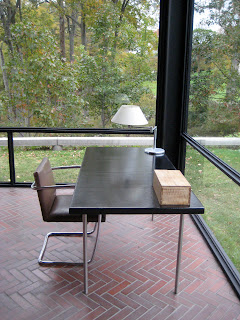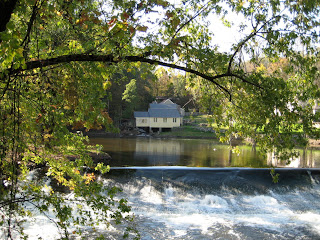This autumn's been quite a season so far. Several architecture and design community events took up much of my time (thus my long absence), and the hunt for design opportunities continues apace. A broken heart threatens to waylay me yet again, but I've resolved to carry on.
Not to worry: I did have some fun. I've been taking pictures when I can, and a couple of day trips provided healthy and welcome respites.
Storm King Art Center
A couple of friends and I made our way to the
Storm King Art Center, in New Windsor, NY, on a day that started out warm and turned humid and hot, an obscenity in October. Sprinkled with large-scale works by some of contemporary art's most prominent artists including
Mark Di Suvero and the late, great Donald Judd, the park grounds—located about an hour north of New York City—are extensive and beautiful, no matter the weather. I can't show you any of the artwork—strictly forbidden by the Storm King folks—but the fall images are from in and around the center. If you're looking for a tryptophan-hangover remedy, the outdoor galleries are open through this Thanksgiving holiday weekend.
The Glass House
 |
| The Glass House and brick-clad Guest House, with the round pool dominating the landscape |
My friend J. and I finally completed our pilgrimage to
Philip Johnson's iconic
Glass House, a must for all design lovers. Located in New Canaan, CT, the house was completed in 1949; Johnson added buildings and structures to the 40+ acre site until the mid-1990s. Johnson, an art historian/curator turned architect, was a great arts patron, supporting artists—many of whom were his friends and stayed as guests or party invitees—right up until his death at age 98 in 2005.
He and historian/curator Henry-Russell Hitchcock coined the term International Style to describe European modernism, which Johnson explored firsthand in the late 1920s and early 1930s. As the Museum of Modern Art's founding curator of its architecture and design department, he mounted the first retrospective of European design and architecture, in 1932. Walter Gropius, Ludwig Mies van der Rohe, Marcel Breuer and others found haven in the U.S. at the rise of Nazism in the 1930s partly because of MoMA's influential show, and Johnson was a tireless advocate of modernism until the 1960s, when he broke from the confines of steel and glass to explore Pop Art, postmodernism and other schools of design thought.
His New Canaan estate was his laboratory, and the various buildings show his unending curiosity. The brick guest house, less than 100 yards from the main house, echoes the Glass House's measurements (it is in fact a twin in all but materials and interior space plan). A library/studio and Ghost House are visible to the left of the grounds' entrance and driveway. The gallery buildings explore different structural elements, including skylights and rotating interior walls for displaying art both small and large scale. The last building completed, an unused visitors center nicknamed Da Monsta, was completed in 1996 and boasts the Dr. Suessian curves and colors of postmodernism and deconstructivism.
 |
| Johnson's library and study, which he used daily until shortly before his death in 2005 |
 |
| The Ghost House was originally built to protect a lily garden from the plentiful deer. It didn't work. |
The Glass House itself is relatively small at 1800 square feet. Johnson changed the space little from 1949. the furniture and materials are original to the house. It's hard to understand how anyone could live in such an open to the landscape house until you step inside and look round. The walls are in fact frames for the lush grounds, hilly and tree-filled vistas that Johnson could admire from anywhere in his home. And he did so for more than 50 years.
 |
| The kitchen |
 |
| The living room. The landscape—by French Renaissance painter Nicolas Poussin—was the only work Johnson showed by an artist he didn't know personally. |
 |
| The study |
 |
| The bedroom |
 |
| The only walls that reached the ceiling housed the well-used fireplace and bathroom. The brick was the same used for the floor, which boast radiant heating, a rarity in the 1950s. |
 |
| The views from the Glass House |
The landscape is very New England, with stone walls crossing the grounds and paths leading the way to and from various buildings and follies. The autumn colors were just beginning to glow and a steady drizzle cut through the chill. It was perfect.
 |
| The path from the entrance, around the main buildings . . . |
 |
| . . . to the Sculpture Gallery . . . |
 |
| A Frank Stella |
 |
| A bronze replica of humble but proud driftwood |
 |
| . . . and the underground Painting Gallery. |
 |
| Andy Warhol portrait of Johnson |
 |
| More Stellas adorn the movable walls. The mechanics are partially visible in the gallery's ceiling. |
 |
| Inside Da Monsta |
 |
| Visitors center entrance. A steady drizzle kept the air chilly. |
 |
| A final look down the path. 'Til we meet again. |













































